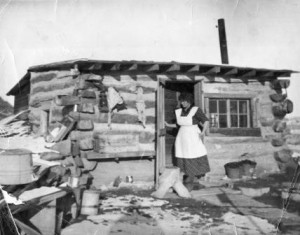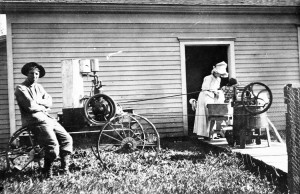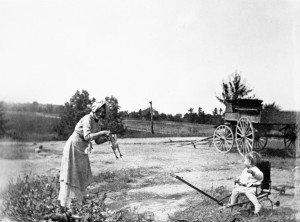
Upon statehood in 1889, 5,600 farms spread across Montana. By 1910, that number had jumped to 26,000. The Enlarged Homestead Act was one reason thousands flooded into Montana, including many married couples. Although federal census records consistently note that women whose husbands were involved in agriculture had no occupations, women were often the linchpins of the family economy and played key roles in building their communities.
Helena Hagadone, Janet Smith, Lilly B. “Ma” Smith, Ruth Garfield, and others represent different experiences, but share a unique sisterhood. What women brought to the marriage influenced the success, and sometimes failure, of the partnership. They were neither as frail nor as frightened as they have sometimes been portrayed.
Frank and Helena Hagadone married in 1913. In 1917, the Hagadones homesteaded with their three children in a hostile place in the Missouri Breaks called the Devil’s Pocket. The Missouri River bottomlands were unbearably hot in summer and cruelly cold in winter. The family grew vegetables and caught fish, but they had no well. They carried river water to the house, let the silt settle, and boiled it for cooking and drinking. Rattlesnakes were everywhere, and one of the children survived a near-fatal bite. After four years, the Hagadones separated. Mrs. Hagadone sent the young girls to board in town and paid for their schooling by working the homestead alone. The girls were glad to leave because their mother had become a mean woman.
Partnerships were sometimes uneven. “I was just like a hired man,” recalled Katie Adams of Hill County. “I was right there. I helped harness the horses and unharness them and hitch them up. And I followed the plow more than once and the harrow and the rake, raked the fields.” Women worked alongside men in haying, threshing, and branding. But they also did the cooking, the washing, and raised the children.

Adams made every minute count. “You’d go to bed about eleven-thirty, twelve o’clock, you’d get up at four, and you go out and help harness the horses, you milked the cows, get breakfast, strain your milk and put it away. Wash up your dishes, feed your chickens and slop the pigs. If there was any time left, you would start your washing, maybe carry your water … heat your water in a boiler, get your washboard and your tub…. Wasn’t many times I’d fool around.”
Husbands perceived that women had more leisure time and so it often fell to them to supplement the family income. “Cream checks” and other financial ventures like selling produce, teaching school, raising chickens and sheep, even mining small claims or taking pictures helped the household survive.
Rose Weaver Lorenson of Drummond said, “The cream check covered everything. That was the bank account…. Lots of times, that was the only money we had…. If it hadn’t been for the chickens, we’d have starved.”
Women’s work made an essential contribution, and according to Jewell Peterson Wolk of Glacier County, many marriages were born of necessity: “There were darn few marriages of love out here among these early beginners…. A man just couldn’t work out in the field all day and then come in and start the beans boiling—it didn’t work. …You realize that washing clothes was almost a two-day operation in the wintertime…. Just running the household was a full-time job, so you went out looking for a woman and you went out fast…. I don’t think I’ve ever heard a homestead wife tell how much she loved her husband. That wasn’t part of it, it was survival.”
Outspoken Janet Smith, the only woman in Montana convicted of sedition, ranched with her husband in the Powder River country. During World War I, she called the Red Cross a fake and bragged that if Americans revolted, she would shoulder a gun and get the president. Both Mrs. Smith and her husband served more than two years at Deer Lodge. The isolation of ranchers like the Smiths made them particularly vulnerable. They did not realize the serious implications of their casual talk.

Lilly Smith, affectionately known as “Ma,” was a ranch wife in Garfield County, and a woman who made difficult choices and material sacrifices. In addition to proving up her own homestead in partnership with her husband, Smith was a practical nurse who helped elderly Doctor Lon Keith deliver scores of babies and assisted him in countless cases. She was by his side when he died of pneumonia in 1918. Smith took charge of the doctor’s household, pressed his black suit, and laid out the body. She took a dress length of fine gray silk—a Christmas gift from her son—from her hastily packed suitcase. New dresses did not come often, but Smith had instinctively known that it would make the perfect lining for Doc Keith’s coffin.
Ruth Garfield was a ranching wife with a young son whose husband was sheriff of newly created Golden Valley County in 1920. Sheriff Garfield had just been elected to a second term when he was fatally shot. Mrs. Garfield set aside her grief to assist the community and serve out her husband’s term. She was Montana’s first female sheriff and served two years.
Despite hardships, many women loved the land and took time to appreciate it. According to Anna Dahl, “It wasn’t just drab, drab work all the time.” Women had to be strong and resilient, and most did more than their part. They played active role in the history of the agricultural frontier. EB
“Nannie Alderson: Pioneer Ranchwoman” provides a closer look the experiences of one iconic ranch life.
Married women weren’t the only female homesteaders in Montana. Learn about single women homesteaders by reading “A Farm of Her Own.”
Are you interested in Montana women in agriculture? You might enjoy reading Laurie Mercier’s article “Montanans at Work: Business Women in Agricultural Communities” and other articles from Montana The Magazine of Western History.
Sources
Armitage, Susan. “Western Women: Beginning to Come into Focus,” Montana: The Magazine of Western History, Vol. 32, No. 3, Summer, 1982.
Kinsey-Cartwirght, Suzan Kinsey. “Jesse and Ruth Lane,” Montana Law Enforcement Officers Memeorial, Garfield County Page, 1999.
Mercier, Laurie K. “Women’s Role in Montana Agriculture,” Montana Heritage: An Anthology of Historical Essays. Robert R. Swartout, Jr. and Harry W. Fritz, eds. Helena: Montana Historical Society, 1992.
Work, Clemens P. Darkest Before Dawn: Sedition and Free Speech in the American West. Santa Fe: University of New Mexico, 2006.
Schillreff, Fern and Jessie M. Shawver. Garfield County: The Golden Years at Montana Historical Society History Wiki.